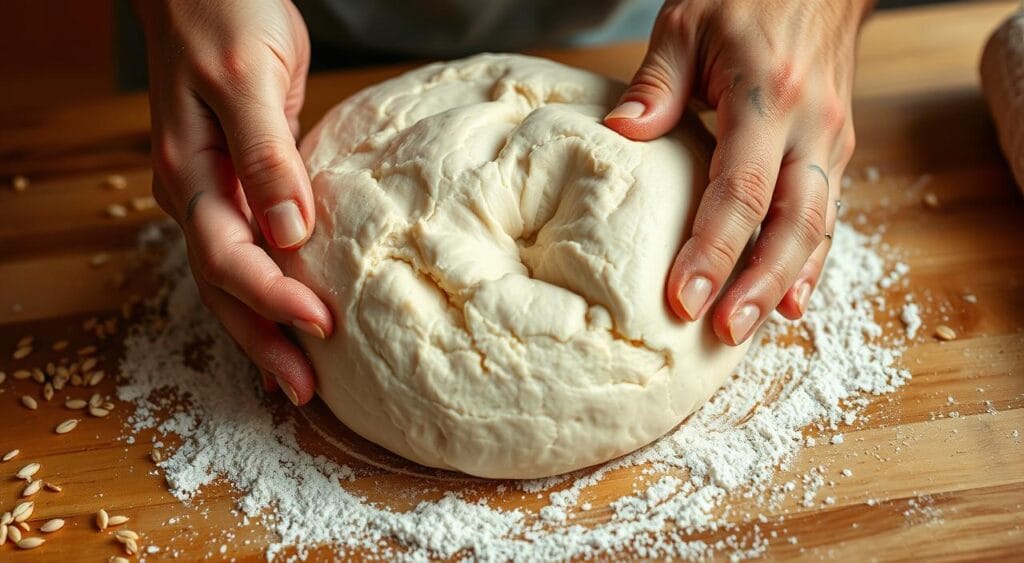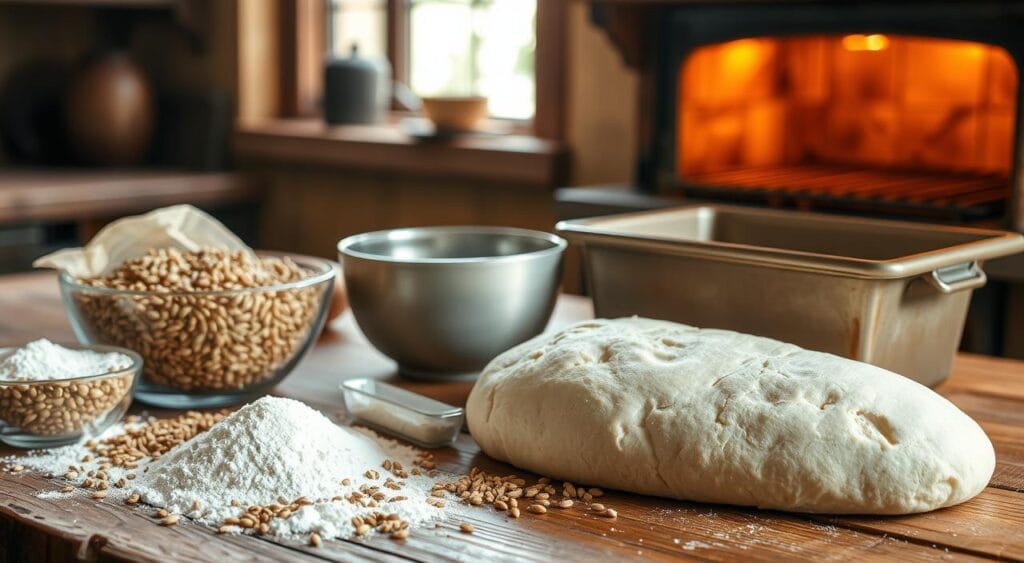Table of Contents
As I enter my kitchen, the smell of fresh bread fills the air. It takes me back to a time when bread was more than food. It was a sacred ritual, a link to our biblical roots. Ezekiel bread, with its sprouted grains, has always been nourishing and spiritually inspiring. Today, I invite you to join me in rediscovering this ancient treasure.
Baking Recipe for Ezekiel Bread with Sprouted Grains at home reminds us of the value of simplicity and tradition. This recipe, inspired by biblical teachings, nourishes our bodies and souls. It connects us to the wisdom of the past and the health of today.
On this baking journey, you’ll learn about sprouted grains. They make each ingredient more nutritious. Every bite of this bread celebrates nature and timeless wisdom.
Whether you’re an experienced baker or new to homemade bread, this recipe will help you. It ensures you can make authentic Ezekiel bread in your kitchen. Let’s start this journey together and enjoy baking bread that nourishes both body and soul.
Key Takeaways
- Ezekiel bread is a biblical bread recipe that offers a wealth of nutritional benefits.
- This homemade recipe uses sprouted grains to unlock the full potential of each ingredient.
- Baking Ezekiel bread at home is a way to honor tradition and connect with the wisdom of the past.
- The recipe is suitable for both seasoned bakers and those new to homemade bread.
- Ezekiel bread is a versatile and nourishing addition to a healthy diet.
Understanding Ezekiel Bread: A Biblical Inspiration for Modern Nutrition
Ezekiel bread, also known as “biblical bread,” has a deep history. It comes from the ancient scriptures. This bread is inspired by the recipe in the book of Ezekiel, showing the value of traditional nutrition.
Historical Origins and Biblical References
The story of Ezekiel bread starts in the Bible. The prophet Ezekiel was told by God to make bread from wheat, barley, beans, lentils, and millet. This recipe was meant to be a nutritious food during hard times.
Nutritional Benefits of Biblical Bread
Ezekiel bread is known for its great nutrition. It’s a sprouted grain bread, packed with vitamins, minerals, and amino acids. The sprouting process makes these nutrients easier for our bodies to use.
Why Choose Sprouted Grain Bread
Choosing sprouted grain bread like Ezekiel bread is smart. It’s less processed, keeping more of its natural goodness. This makes it a healthier option for those looking for a nutritious whole grain bread.
“Ezekiel bread is a true testament to the enduring wisdom of traditional nutrition, blending ancient biblical principles with modern-day health and wellness.”
Essential Ingredients for Authentic Ezekiel Bread
If you’re looking to make Ezekiel bread with sprouted grains, you need to know the key ingredients. This bread, also known as vegan bread recipe, is inspired by the Bible. It’s made from a mix of grains and legumes, as instructed by God to the prophet Ezekiel.
The heart of Ezekiel bread is the sprouted grains. These grains are wheat, barley, millet, spelt, and lentils. Each grain adds important nutrients, texture, and flavor to the bread.
- Wheat Berries: These give the bread its chewiness.
- Barley: It adds a sweet taste and a nutty flavor.
- Millet: It makes the bread light and fluffy, with a mild taste.
- Spelt: This ancient grain adds an earthy taste and more nutrition.
- Lentils: They add protein, fiber, and a creamy texture to the bread.
The sprouting process is crucial for authentic Ezekiel bread. It makes the grains and legumes more nutritious. Sprouting unlocks vitamins, minerals, and enzymes, making the bread very nutritious.
With the right ingredients, you can make a vegan bread recipe that’s both healthy and tasty. Ezekiel bread offers a rich history and lots of nutrition. It’s a great choice for your baking.
The Complete Guide to Sprouting Grains for Your Bread
Learning to sprout grains is key to making your homemade sprouted grain bread healthier. It makes the bread taste nutty and boosts its nutritional value. Here’s how to sprout grains right for the best sprouted grain bread.
Best Practices for Sprouting Different Grains
Each grain type has its own sprouting needs. Here’s what to do:
- Wheat berries: Soak for 12-24 hours, then rinse and drain every 8-12 hours until sprouts appear.
- Rye berries: Soak for 8-12 hours, then rinse and drain every 6-8 hours until sprouts emerge.
- Barley: Soak for 8-12 hours, then rinse and drain every 6-8 hours until sprouts form.
- Buckwheat: Soak for 4-6 hours, then rinse and drain every 4-6 hours until sprouts develop.
Common Sprouting Mistakes to Avoid
There are a few mistakes to watch out for:
- Oversoaking the grains, which can lead to mold and bacterial growth.
- Inadequate rinsing and draining, resulting in stagnant water and hindered sprouting.
- Exposing the grains to direct sunlight, which can cause them to turn green and develop a bitter flavor.
- Failing to properly store the sprouted grains, leading to premature spoilage.
Time and Temperature Requirements
Timing and temperature are crucial for sprouting grains. Here’s a general guide:
| Grain Type | Soaking Time | Sprouting Time | Optimal Temperature |
|---|---|---|---|
| Wheat berries | 12-24 hours | 24-48 hours | 65-75°F (18-24°C) |
| Rye berries | 8-12 hours | 18-36 hours | 65-75°F (18-24°C) |
| Barley | 8-12 hours | 18-36 hours | 65-75°F (18-24°C) |
| Buckwheat | 4-6 hours | 12-24 hours | 65-75°F (18-24°C) |
Follow these tips, avoid common mistakes, and use the right timing and temperature. You’ll make delicious homemade sprouted bread with all the health benefits of sprouted grain bread.
“Sprouting grains is a game-changer for your homemade bread, unlocking a world of flavor and nutrition.”
Recipe for Ezekiel Bread with Sprouted Grains
Making Ezekiel bread at home is a rewarding journey. It lets you enjoy the health benefits of this ancient bread. This guide will help you make a tasty and healthy Ezekiel bread recipe, whether you’re a pro or a beginner.
To start, you need the right ingredients for authentic Ezekiel bread. These include:
- Sprouted whole wheat flour
- Sprouted barley flour
- Sprouted millet flour
- Sprouted lentil flour
- Sprouted spelt flour
- Sprouted brown rice flour
- Yeast
- Water
- Salt
With all the ingredients ready, it’s time to mix and knead the dough. This step is key for the bread’s texture and structure. Make sure to knead well to develop the dough’s gluten, making it smooth and elastic.
| Ingredient | Quantity |
|---|---|
| Sprouted whole wheat flour | 2 cups |
| Sprouted barley flour | 1 cup |
| Sprouted millet flour | 1/2 cup |
| Sprouted lentil flour | 1/2 cup |
| Sprouted spelt flour | 1/2 cup |
| Sprouted brown rice flour | 1/2 cup |
| Yeast | 1 tablespoon |
| Water | 1 1/2 cups |
| Salt | 1 teaspoon |
After kneading, let the dough rise. This step is vital for Ezekiel bread’s flavor and texture. Ensure the dough rises in a warm, draft-free spot.
Now, it’s time to bake your Ezekiel bread. Follow the baking instructions closely for a golden-brown loaf. Enjoy your homemade Ezekiel bread, made with love in your kitchen.
“Ezekiel bread is a true testament to the power of ancient grains and the importance of embracing traditional baking methods. This recipe allows you to bring the flavors of the Bible to your modern kitchen.”
Tools and Equipment Needed for Baking
Making delicious homemade sprouted bread or whole grain bread at home needs the right tools. You’ll need basic baking tools and some extra gear for more advanced bakers. The right tools can help you get the perfect bread.
Essential Baking Tools
- Sturdy mixing bowls: Get high-quality stainless steel or glass bowls for kneading and rising.
- Bread loaf pans: Pick the right size and material, like nonstick metal or ceramic, for even baking.
- Measuring cups and spoons: Accurate measurements are crucial for making great bread, so have a reliable set ready.
- Dough scraper: This tool helps you handle the dough gently and portion it for shaping.
- Bread lame or sharp knife: Use it to score the dough’s top before baking, making those beautiful slashes.
Optional Equipment for Advanced Bakers
If you want to improve your whole grain bread recipe skills, consider these optional tools:
- Stand mixer with dough hook attachment: This machine kneads the dough for you, saving time and effort.
- Banneton proofing basket: These baskets help shape and support the dough during the final rise, making a beautiful loaf.
- Baking stone or steel: These items mimic a professional oven, helping create a crisp crust.
- Mister or spray bottle: Lightly misting the dough during baking can improve the crust’s texture and color.
- Oven thermometer: This ensures your oven is at the exact temperature for perfect baking every time.
Having the right tools and equipment, no matter your skill level, makes baking homemade sprouted bread or whole grain bread enjoyable. Start with the basics and add more as you become more skilled.
Step-by-Step Mixing and Kneading Process
Making the perfect Ezekiel bread with sprouted grains needs a careful mix of techniques. Start by getting your ingredients and tools ready. In a big mixing bowl, mix the sprouted grains, flour, yeast, and other dry stuff. Stir gently to mix them well.
Then, add the warm water, honey, and oil slowly. Keep mixing until you get a shaggy dough.
Now, it’s time to knead the dough. Put it on a lightly floured surface and knead for about 10 minutes. This makes the dough smooth and elastic. It’s important to knead gently to avoid a tough bread.
- Knead the dough for about 10 minutes, using a gentle, rhythmic motion.
- Try to get a smooth, elastic dough, without overworking it.
- Add flour as needed to stop sticking, but don’t add too much.
- Shape the dough into a ball, ready for the next steps.

After mixing and kneading, you’re almost there. You’ll soon have a tasty, healthy Ezekiel bread. Take your time and trust the process. The effort will be worth it!
Proper Fermentation and Rising Techniques
Making the perfect ezekiel bread recipe needs a good grasp of fermentation and rising. These steps are key to the bread’s texture, taste, and nutrition. They bring out the best in sprouted grains.
Understanding the Fermentation Process
Fermentation gives ezekiel bread its unique chewy and nutty taste. It’s when enzymes in sprouted grains turn starches into simple sugars. These sugars feed the yeast, creating a complex flavor and a light crumb.
Optimal Rising Conditions
The dough needs a warm, draft-free spot to rise well. Keep the temperature between 75-85°F. Let it rise for 1-2 hours, until it doubles in size. When it’s ready, the dough will be soft and elastic.
| Fermentation Time | Rising Time | Temperature Range |
|---|---|---|
| 1-2 hours | 1-2 hours | 75-85°F |
Knowing how to ferment and rise is key to making great ezekiel bread. It lets you create loaves that look good and taste amazing.
“The secret to the perfect ezekiel bread recipe lies in the balance of fermentation and rising. It’s a dance of patience and precision that unlocks the true potential of these nutrient-dense grains.”
Baking Instructions and Temperature Guidelines
Baking the perfect Ezekiel bread with sprouted grains or homemade sprouted bread is an art. It needs careful attention. Follow these steps for a flawless loaf every time.
First, heat your oven to 375°F (190°C). This temperature is perfect for even baking and a golden crust. Grease a standard loaf pan with oil or butter to prevent sticking.
- Gently put the dough into the greased loaf pan, without deflating it.
- Bake for 40-45 minutes, or until the top is dark brown and a toothpick comes out clean.
- For a crispy crust, brush the top with egg white or melted butter in the last 5-10 minutes.
Watch your Ezekiel bread closely towards the end. It should reach 205-210°F (96-99°C) with a food thermometer. This means it’s fully baked and ready to take out.
“The secret to a fantastic homemade sprouted bread lies in the baking process. Follow these guidelines, and you’ll be rewarded with a loaf that’s both visually stunning and bursting with flavor.”
Let the bread cool in the pan for 10 minutes before moving it to a wire rack. This helps it keep its shape and prevents a soggy crust. Once cool, your Ezekiel bread with sprouted grains is ready to be sliced and enjoyed!

Storage Tips and Shelf Life
Keeping your homemade Ezekiel bread fresh is all about proper storage. Store it in an airtight container at room temperature. This keeps the moisture in and prevents drying out.
Don’t store Ezekiel bread in the fridge. The cool, dry air can make it stale faster.
Best Storage Methods
For the best storage, use a resealable plastic bag or an airtight container. Make sure to squeeze out any air before sealing. This keeps the bread fresh longer.
When stored right, your Ezekiel loaf can last 3-5 days at room temperature.
Freezing and Thawing Guidelines
Freezing is a great way to keep your Ezekiel bread fresh longer. Wrap the loaf or slices in plastic wrap or foil, then in a freezer-safe bag. Frozen, it stays good for up to 3 months.
To thaw, just leave it at room temperature. Or, toast the slices for a quick, tasty meal.
FAQ
What is Ezekiel bread and why is it considered a healthy choice?
Ezekiel bread is made from sprouted grains and legumes. It’s named after a biblical passage. It’s known for its high nutritional value.
It contains sprouted wheat, barley, millet, spelt, lentils, and soybeans. This mix provides a complete protein and lots of vitamins, minerals, and fiber.
What are the benefits of using sprouted grains in homemade bread?
Sprouting grains before baking has many benefits. It unlocks the grains’ full nutritional potential. This makes the nutrients easier for your body to absorb.
Sprouted grains also have a lower glycemic index. This is good for those watching their blood sugar. Plus, the sprouting process makes the bread easier to digest.
What ingredients do I need to make Ezekiel bread at home?
You’ll need sprouted wheat, barley, millet, spelt, lentils, and soybeans. You’ll also need water, yeast, and a pinch of salt. These ingredients give Ezekiel bread its unique taste and nutritional profile.
How do I properly sprout the grains for Ezekiel bread?
Sprouting grains for Ezekiel bread needs planning and attention. Start by soaking the grains in water for hours. Then, drain and rinse them until they sprout.
The sprouting time and temperature vary by grain type. Make sure to follow specific guidelines. Properly sprouted grains will show visible sprouts.
What’s the best way to mix and knead the Ezekiel bread dough?
Mix and knead the dough gently to avoid damaging the sprouted grains. Combine all sprouted ingredients in a bowl. Add water and knead until smooth and elastic.
Be careful not to overmix. This can make the bread dense. Gently mix the ingredients to keep the sprouted grains intact.
How do I ensure the Ezekiel bread dough rises properly?
Proper fermentation and rising are key for the perfect texture. Knead the dough, then place it in a lightly oiled bowl. Cover it and let it rise in a warm, draft-free place.
This can take 1-2 hours. Once risen, punch down the dough to release air. Shape it into a loaf and let it rise again before baking.
What’s the best way to bake Ezekiel bread?
Bake the bread at 350°F (175°C) for 30-40 minutes. The crust should be golden, and a toothpick should come out clean. Watch it closely to avoid overbrowning.
Let the loaf cool completely before slicing. This ensures the best flavor and texture.
How should I store Ezekiel bread to keep it fresh?
Store the bread in an airtight container at room temperature for 3-4 days. You can also freeze the slices for longer storage. Thaw frozen slices at room temperature or in the toaster.
Proper storage keeps the bread fresh and nutritious.

